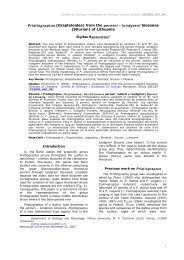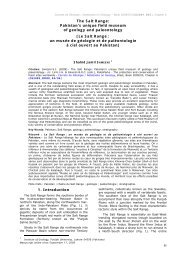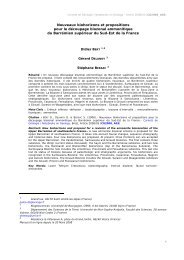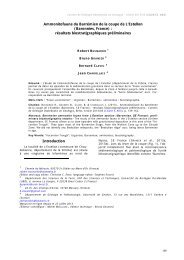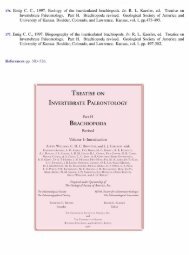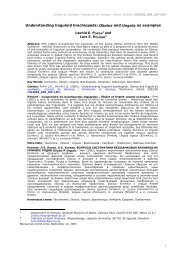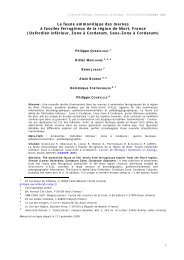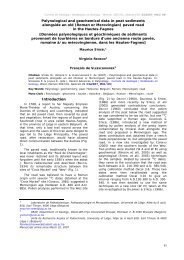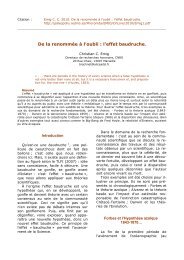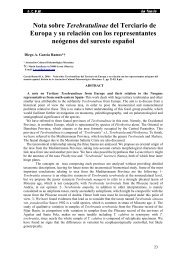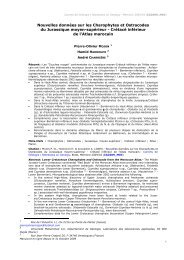Albien dans les Pyrénées ariégeoises (France) - Paleopolis
Albien dans les Pyrénées ariégeoises (France) - Paleopolis
Albien dans les Pyrénées ariégeoises (France) - Paleopolis
You also want an ePaper? Increase the reach of your titles
YUMPU automatically turns print PDFs into web optimized ePapers that Google loves.
Carnets de Géologie [Notebooks on Geology] - Article 2013/01 (CG2013_A01)<br />
Nouvel<strong>les</strong> données paléontologiques et stratigraphiques<br />
au passage Aptien – <strong>Albien</strong><br />
<strong>dans</strong> <strong>les</strong> Pyrénées ariégeoises (<strong>France</strong>)<br />
Jacques REY 1, 2<br />
Josep Anton MORENO-BEDMAR 3<br />
Michel BILOTTE 1, 4<br />
Ricardo MARTÍNEZ 5<br />
Résumé : La découverte d'ammonites du passage Aptien - <strong>Albien</strong> (biozones à Hypacanthoplites jacobi<br />
et à Leymeriella tardefurcata), <strong>dans</strong> la série urgonienne de la couverture du massif de l'Arize invalide<br />
l'attribution antérieure au Clansayésien inférieur proposée sur des arguments paléontologiques non<br />
contraints.<br />
Mots-Clefs : Ammonite ; <strong>Albien</strong> ; Pyrénées ; Ariège ; <strong>France</strong>.<br />
Citation : REY J., MORENO-BEDMAR J.-A., BILOTTE M. & MARTINEZ R. (2013).- Nouvel<strong>les</strong> données paléontologiques<br />
et stratigraphiques au passage Aptien – <strong>Albien</strong> <strong>dans</strong> <strong>les</strong> Pyrénées ariégeoises (<strong>France</strong>).- Carnets<br />
de Géologie [Notebooks on Geology], Brest, Article 2013/01 (CG2013_A01), p. 67-81.<br />
Abstract: New paleontological and stratigraphical data at the Aptian - Albian transition in the<br />
Ariege Pyrenees (<strong>France</strong>).- The discovery of ammonites of the Aptian - Albian transition (Hypacanthoplites<br />
jacobi and Leymeriella tardefurcata biozones) in the Urgonian series from the sedimentary<br />
section exposed in the Arize massif invalidates their former attribution to the lower Clansayesian which<br />
was proposed on the basis of unconstrained paleontological arguments.<br />
Key Words: Ammonite; Albian; Pyrenees; Ariège; <strong>France</strong>.<br />
Extended English Abstract<br />
New paleontological and<br />
stratigraphical data<br />
at the Aptian - Albian transition<br />
in the Ariege Pyrenees (<strong>France</strong>)<br />
Introduction<br />
In the Sérou region, the Northern Mesozoic<br />
cover of the Arize massif is characterized by<br />
"Urgonian" limestones, which precede Albian<br />
black sha<strong>les</strong> and the "complexe flyschoïde à<br />
floridées". It has been shown (REY, 1963, 1964)<br />
that these "Urgonian" limestones contain intercalations<br />
of "clay-silty" limestone on the south<br />
side of the Lescalé syncline (Fig. 1). On the first<br />
of these intercalations, COMBES et al. (1968) collected<br />
fauna such as sea urchins, ammonites<br />
and benthic microfauna that allowed them to locate<br />
the Aptian - Albian boundary. Subsequently,<br />
based on bibliographical data, ESQUEVIN<br />
et al. (1971) and PEYBERNÈS (1976) attributed<br />
these intercalations to the Clansayesian and<br />
identified a transgression of late Aptian age<br />
1<br />
Service Commun d'Étude et de Conservation des Collections Patrimonia<strong>les</strong>, Université Paul Sabatier, 118 route<br />
de Narbonne, F-31062 Toulouse cedex (<strong>France</strong>)<br />
2<br />
jacques.rey3@free.fr<br />
3<br />
Departamento de Paleontología, Instituto de Geología, Universidad Nacional Autónoma de México, Ciudad Universitaria,<br />
Delegación Coyoacán, 04510 México, D.F. (Mexique)<br />
josepamb@geologia.unam.mx<br />
4<br />
Géosciences Environnement Toulouse, 14 avenue E. Belin, F-31400 Toulouse (<strong>France</strong>)<br />
michel.bilotte@get.obs-mip.fr<br />
5<br />
Departament de Geologia (Paleontologia), Universitat Autònoma de Barcelona, Edifici Cs, E-08193-Bellaterra,<br />
Barcelona (Espagne)<br />
ricard.martinez@uab.cat<br />
Manuscript online since February 28, 2013<br />
[Editor: Michel MOULLADE; copy editor: Christian C. EMIG; language editor: Phil SALVADOR]<br />
67
Carnets de Géologie [Notebooks on Geology] - Article 2013/01 (CG2013_A01)<br />
(sensu anglico, cf. MOULLADE et al., 2011) in some<br />
areas above the Albian limestone or on the<br />
Jurassic substratum manifested as bauxite<br />
pockets (PEYBERNÈS & SOUQUET, 1972). The collection<br />
of in situ new ammonite fauna, and the<br />
revision of the unpublished specimens of the<br />
Chanoine J.J. POUECH collection, helped to provide<br />
more precise chronostratigraphical data for<br />
the model presented herein. The new fauna is<br />
dated from the Aptian - Albian transition. This<br />
age calibration partly reveals as incorrect the<br />
previous age attribution of the level of silty-clay<br />
limestone with ammonites to the early Clansayesian.<br />
Furthermore, it allows us to attribute<br />
the underlying Urgonian limestone to a younger<br />
age. This new age calibration confirms the gap<br />
in the greater part of the Aptian in the Arize<br />
massif. It also raises the problem of the chronostratigraphic<br />
value of the micropaleontological<br />
markers used to date the latest Aptian.<br />
The ammonite fauna<br />
paleontological study<br />
(J.A. M.-B. & R. M.)<br />
The Lower Cretaceous of the Arize massif, in<br />
the Durban region, contains the following species:<br />
Epanisoceras sp., Pl. 2, figs. E-G; Hypacanthoplites<br />
cf. milletianus (d'ORBIGNY, 1841),<br />
Pl. 1, figs. E-F, I, J, Pl. 2, figs. B-D; Hypacanthoplites<br />
milletioides CASEY, 1961, Pl. 2, figs. H-<br />
I; Hypacanthoplites cf. milletioides, Pl. 2, fig. A;<br />
Hypacanthoplites sp. 1, Pl. 1, figs. A-B; Hypacanthoplites<br />
sp. 2, Pl. 1, figs. C-D, and Hypacanthoplites<br />
sp. 3, Pl. 1, figs. G-H.<br />
The Epanisoceras genus<br />
The genera of the heteromorphic ammonites<br />
Epanisoceras, Ephamulina and Pseudocrioceratites<br />
show great similarities. The Epanisoceras<br />
genus was defined by COLLIGNON (1962) based<br />
on the type species Epanisoceras raulinianiforme<br />
(BREISTROFFER in COLLIGNON, 1937) from<br />
the upper Aptian of Madagascar. The Ephamulina<br />
genus was defined by COLLIGNON (1963) based<br />
on the species Ephamulina trituberculata<br />
(COLLIGNON, 1949), and this taxon is associated<br />
with other species such as Ephamulina arcuata<br />
(COLLIGNON, 1962) and Ephamulina curvata COL-<br />
LIGNON, 1963. In Madagascar, the chronostratigraphical<br />
range of these taxa is Early to<br />
Middle Albian. The Pseudocrioceratites genus<br />
was defined by EGOIAN (1969) based on the<br />
type species Pseudocrioceratites pseudoelegans;<br />
it is also associated with other species<br />
(e.g., Pseudocrioceratites rotundus EGOIAN,<br />
1969) in the upper Aptian from the North of<br />
Caucasus. The species attributed to those three<br />
genera are generally represented by fragmentary<br />
specimens. Thus, the present state of<br />
knowledge about these taxa remains incomplete.<br />
This can lead to confusion. For example,<br />
AVRAM (2002) incorrectly assigned the Late Barremian<br />
and the Early Aptian species to the genus<br />
Pseudocrioceratites when they seem more<br />
likely to belong to the Ancyloceratidae family,<br />
similar to the Audouliceras genus.<br />
Some authors also suggest that Pseudocrioceratites<br />
is synonymous with the Acantholytoceras<br />
genus defined by SPATH in 1923 (WRIGHT<br />
et al., 1996; VERMEULEN, 2006). We disagree<br />
with that suggestion since Acantholytoceras<br />
shows well distributed spines, which are not<br />
present in the Pseudocrioceratites genus, as has<br />
been noted by SZIVES & MONKS (2002). Some<br />
authors recognize the existing similarities between<br />
the Pseudocrioceratites and Ephamulina<br />
genera and consider them to be synonymous,<br />
giving priority to the Ephamulina genus (SZIVES<br />
& MONKS, 2002; JOLY & DELAMETTE, 2008). In<br />
other cases, authors (DEMAY & THOMEL, 1986;<br />
MORENO-BEDMAR et al., 2008) have used the<br />
Epanisoceras genus for the late Aptian forms,<br />
which is similar to the Ephamulina. We consider<br />
that the Epanisoceras, Ephamulina and Pseudocrioceratites<br />
genera are synonymous and we<br />
use the older Epanisoceras genus.<br />
The Hypacanthoplites genus<br />
All the taxa similar to the forms described by<br />
FRITEL (1906) and COLLET (1907) coming from<br />
the North of Germany have been named under<br />
the original term of Hypacanthoplites. According<br />
to BULOT (2007, 2010), various genera that<br />
belong to the Acanthohoplitinae subfamily are<br />
currently included in the Hypacanthoplites<br />
genus. This author notes that the criteria for<br />
recognition of the Hypacanthoplites genus is the<br />
persistence of lateral tuberc<strong>les</strong> in the middle of<br />
the flank. BULOT considers that the traditional<br />
criteria used of the flat venter, present during<br />
the first stages of growth, is not the most<br />
important. It seems thus that the authentic<br />
Hypacanthoplites must be determined during<br />
the juvenile ontogenetic stage, using the presence<br />
or absence of tuberc<strong>les</strong> as the determining<br />
criteria. Although these differences in<br />
the juvenile forms are clearly visible in JOLY and<br />
DELAMETTE (2008, Fig. 7, G and H), these<br />
authors assigned the two forms to the same<br />
genus Hypacanthoplites. For this reason, BULOT<br />
(2007, 2010) suggests that we should reconsider<br />
the different species that are included in the<br />
Hypacanthoplites genus. LATIL (2011) incorporates<br />
BULOT's ideas (2007, 2010) in his study on<br />
upper Aptian to Middle Albian ammonites of<br />
Tunisia. He defines the new Mellegueiceras<br />
genus which, classically would be included in<br />
the Hypacanthoplites genus. The definition of<br />
this new genus allows us to establish the existing<br />
differences between the upper part of the<br />
upper Aptian and the lowermost Albian Acanthohoplitinae<br />
and clarify the taxonomy as well<br />
as their biostratigraphical range. The problem<br />
related to the Hypacanthoplites genus has also<br />
been recognized by REBOULET et al. (2011), who<br />
advocated a taxonomic revision of the group.<br />
68
Carnets de Géologie [Notebooks on Geology] - Article 2013/01 (CG2013_A01)<br />
Despite foregoing remarks in this article,<br />
because of the lack of a taxonomic revision of<br />
the Hypacanthoplites genus and the impossibility<br />
of observing the juvenile ontogenetic stage in<br />
our specimens, we have opted, in this work, to<br />
apply the broadest traditional understanding of<br />
the Hypacanthoplites genus. The same approach<br />
has been used by many authors (CASEY,<br />
1950, 1961, 1965; FÖLLMI, 1989; RUFFELL &<br />
OWEN, 1995; BARABOSHKIN, 1999; KENNEDY et al.,<br />
2000; MUTTERLOSE et al., 2003; RAISOSSADAT,<br />
2006; JOLY & DELAMETTE, 2008; MATRION, 2010).<br />
Additionally, we examined an adult/subadult<br />
macroconch (Pl. 1, figs. A-B) and an<br />
adult/sub-adult microconch (Pl. 2, figs. C-D) in<br />
the specimens studied in this work. The presence<br />
of a sexual dimorphism in the Hypacanthoplites<br />
genus was highlighted by KEMPER (1982),<br />
KENNEDY et al. (2000) and BULOT (2007, 2010).<br />
The adult macroconchs have, depending on the<br />
species, dimensions commonly varying from 15<br />
to 30 centimeters for the maximum diameter,<br />
but can be even bigger (ULLASTRE & MASRIERA,<br />
2006, Fig. 3; MATRION, 2010, Fig. 129B). The<br />
maximum diameter of the adult microconchs<br />
can range from 4 to 8 centimeters.<br />
We recognize two species, Hypacanthoplites<br />
cf. milletianus (d'ORBIGNY, 1841) and Hypacanthoplites<br />
milletioides CASEY, 1961, in the specimens<br />
studied which are associated with Hypacanthoplites<br />
cf. milletioides. Our conception of<br />
the species Hypacanthoplites milletianus is not<br />
based on d'ORBIGNY's idealized figurations<br />
(1841, Pl. 77, figs. 1-5), but on the lectotype<br />
coming from the Novion-Porcien (Ardennes) originally<br />
illustrated by CASEY (1965, text-fig. 160<br />
G-F) and later by GUÉRIN-FRANIATTE in GAUTHIER<br />
et al. (2006, Pl. 33, fig. 9a-b). Our specimens<br />
(UPS-JR-MB 03, UPS-JR-MB 04 and UPS-JR-MB<br />
05) show great similarities with the Hypacanthoplites<br />
milletianus lectotype. The Hypacanthoplites<br />
milletioides species comes from<br />
England; it was described and illustrated by<br />
CASEY (1961, 1965). The specimens studied in<br />
this work and identified as Hypacanthoplites<br />
milletioides and Hypacanthoplites cf. milletioides<br />
show a great similarity to the English<br />
forms.<br />
Biostratigraphic results<br />
The establishment of the Aptian - Albian<br />
boundary is discussed in several papers (e.g.,<br />
KENNEDY et al., 2000; OWEN et al., 2002) and<br />
remains open to debate. However, KENNEDY et<br />
al. (2000) put forth a solid conception of the<br />
Aptian - Albian boundary which was followed in<br />
successive versions of the Lower Cretaceous<br />
Mediterranean standard zonation until the most<br />
recent version of REBOULET et al. (2011), which<br />
is the zonation that we use in the present work.<br />
The species of the Epanisoceras genus are<br />
present from the upper Aptian to the Middle<br />
Albian. The species of the Hypacanthoplites genus<br />
appear in the late Aptian in the Hypacanthoplites<br />
jacobi biozone and are present until<br />
the lower part of the Lower Albian, in the Leymeriella<br />
tardefurcata biozone. During the late<br />
Aptian, these species present flexuous ribs while<br />
the Early Albian forms have straight ribs<br />
(AMÉDRO, 1992; ROBERT et al., 2001; GUÉRIN-FRA-<br />
NIATTE in GAUTHIER et al., 2006).<br />
The species herein studied can be divided<br />
into three groups:<br />
A. Specimens collected by some of the authors<br />
of this work (BILOTTE and/or REY) in the 1B<br />
stratigraphic interval, see Fig. 2.<br />
B. Specimens of the historical collections that<br />
can we can assign, with ample confidence,<br />
to the 1B stratigraphic interval.<br />
C. Specimens of the historical collections that<br />
we cannot assign with confidence to the 1B<br />
stratigraphic interval.<br />
Group A is represented by four specimens:<br />
Hypacanthoplites sp. 2 (Pl. 1, figs. C-D) Hypacanthoplites<br />
cf. milletianus (Pl. 1, figs. E-F, I-H)<br />
and Hypacanthoplites sp. 3 (Pl. 1, figs. G-H).<br />
The Hypacanthoplites milletianus species is an<br />
Early Albian taxon which was attributed to the<br />
Leymeriella tardefurcata biozone (PEYBERNÈS,<br />
1976; LATIL, 1994; MATRION, 2010). Hypacanthoplites<br />
sp. 2 seems to have flexuous ribs but<br />
this is caused by tectonic plastic deformation.<br />
Actually their ribs are straight, a characteristic<br />
shared with Hypacanthoplites cf. milletianus.<br />
Both taxa can be attributed to the Early Albian.<br />
In contrast, Hypacanthoplites sp. 3 shows<br />
slightly flexuous ribs and for this reason can be<br />
attributed to late Aptian age. According to this<br />
age assignment, the 1B stratigraphic interval<br />
contains the Aptian - Albian transition.<br />
Group B is represented by three specimens:<br />
Hypacanthoplites cf. milletioides (Pl. 2, figs. A),<br />
Hypacanthoplites cf. milletianus (Pl. 2, figs. C-<br />
D) and Hypacanthoplites milletioides (Pl. 2, figs.<br />
H-I). The Hypacanthoplites milletioides is a very<br />
characteristic species considered by CASEY<br />
(1961) as an index form of its homonymous<br />
sub-biozone, which is located in the middle part<br />
of the Leymeriella tardefurcata biozone. These<br />
three specimens can be attributed to the Early<br />
Albian.<br />
Group C is represented by three specimens:<br />
Hypacanthoplites sp. 1 (Pl. 1, figs. A-B), Hypacanthoplites<br />
cf. milletianus (Pl. 2, fig. B) and<br />
Epanisoceras sp. (Pl. 2, figs. E-G). Hypacanthoplites<br />
sp. 1 has flexuous ribs and this fragment<br />
of a big Hypacanthoplites belongs to the upper<br />
Aptian. Hypacanthoplites cf. milletianus is an<br />
Early Albian taxon and Epanisoceras sp. can be<br />
present in the upper Aptian and also in the<br />
Albian.<br />
69
Carnets de Géologie [Notebooks on Geology] - Article 2013/01 (CG2013_A01)<br />
In conclusion the ammonoids herein studied<br />
characterize the Hypacanthoplites jacobi and<br />
Leymeriella tardefurcata biozones of the standard<br />
tethysian zonation of REBOULET et al.<br />
(2011). Using the age assignment of the<br />
ammonoids of groups A and B, we can assign<br />
the 1B stratigraphic interval to the Aptian -<br />
Albian transition. We note the absence of other<br />
Albian ammonoids taxa, for example, some<br />
species of the genus Leymeriella. We do not<br />
know exactly the reason why we do not find<br />
other Albian taxa. Perhaps, the small number of<br />
specimens reduces the probability of finding<br />
any particular typical Albian taxon. Another<br />
possible reason could be that in the 1B stratigraphic<br />
interval, which recorded just the boundary<br />
of the Aptian - Albian age, the typical<br />
Albian ammonoids faunas were not yet developed.<br />
The age of the ammonites studied here is<br />
very similar to the age of the maximum transgressive<br />
zone of the Ap6 sequence of the HAR-<br />
DENBOL et al. (1998) and also to the age of the<br />
sequence S. D. 2 reported by ROBERT et al.<br />
(2001) in the Pyrenees. This marine transgression<br />
is the most important of the Lower<br />
Albian and corresponds to the PAQUIER level, an<br />
Oceanic Anoxic Event (OAE) inside the OAE 1b<br />
set (FÖLLMI et al., 2006). The Ap6 contains the<br />
Aptian - Albian transition, which is consistent<br />
with the biostratigraphic results obtained in this<br />
work for the 1B stratigraphic interval.<br />
Conclusions<br />
The discovery of a significant ammonite<br />
fauna of the Late Aptian, Hypacanthoplites<br />
jacobi biozone and Early Albian, Leymeriella<br />
tardefurcata biozone in a level previously attributed<br />
to the lower Clansayesian, allows us, for<br />
the first time, to locate the position of the<br />
Aptian - Albian boundary in the Arize massif as<br />
being in the 1B stratigraphic interval. This<br />
discovery leads to the rejection of the early<br />
Clansayesian age formulated for this level by<br />
means of a list of ammonites taken from literature<br />
and considered as characteristic of a "Ariege<br />
Province", without specific knowledge of its<br />
exact provenance. Comparable mistakes, which<br />
have already been denounced in the Albian of<br />
the Pech de Foix, make the paleogeographical<br />
reconstructions proposed for the Albian of the<br />
Ariégeois North-Pyrenées obsolete. The result of<br />
this new biostratigraphic precision shows that<br />
the chronostratigraphic range of micropaleontological<br />
markers, particularly those used to date<br />
the Clansayesian (early-middle-late ?), should<br />
be revised.<br />
Texte Français Intégral<br />
1. Introduction<br />
Dans le Pays de Sérou, la couverture mésozoïque<br />
septentrionale du massif de l'Arize se<br />
singularise en particulier par l'important développement<br />
de calcaires de faciès urgonien qui<br />
précèdent <strong>les</strong> marnes noires et le complexe<br />
flyschoïde à floridées de l'<strong>Albien</strong>. L'étude détaillée<br />
(REY, 1963, 1964) de différentes successions<br />
lithologiques aux abords de la vallée de l'Arize a<br />
montré que ces calcaires "urgoniens" admettaient<br />
sur le flanc Sud du synclinal de Lescalé<br />
(Fig. 1) des intercalations de calcaires argilogréseux.<br />
La première intercalation, épaisse de<br />
20 à 25 m et située une cinquantaine de mètres<br />
au-dessus de la base des calcaires urgoniens<br />
(niveau 1B, Fig. 2), est connue entre <strong>les</strong> méridiens<br />
de Durban et de Rimont. Plus à l'Est et<br />
sur le flanc septentrional du synclinal de Lescalé,<br />
elle disparaît sous le biseau stratigraphique<br />
des calcaires urgoniens plus récents. A<br />
l'Ouest du méridien de Rimont, elle passe latéralement<br />
à des marnes qui se confondent avec<br />
<strong>les</strong> marnes noires de l'<strong>Albien</strong> moyen. Dans ce<br />
premier niveau de calcaires argilo-gréseux ont<br />
été récoltées des faunes (oursins, ammonites)<br />
et des microfaunes benthiques qui ont permis<br />
de situer ce niveau au passage Aptien - <strong>Albien</strong><br />
(COMBES et al., 1968). Ultérieurement, <strong>dans</strong> une<br />
synthèse des séries de l'Aptien et de l'<strong>Albien</strong><br />
nord-pyrénéen, ESQUEVIN et al. (1971) ont précisé<br />
<strong>les</strong> particularités sédimentologiques, biologiques<br />
et paléogéographiques d'une "Province<br />
Ariégeoise" caractérisée par des horizons bauxitiques<br />
"dont le plus important se situe à la base<br />
des premiers niveaux de l'Aptien supérieur" ; à<br />
l'appui de cette synthèse, des faunes - essentiellement<br />
des ammonites - ont été citées ; <strong>les</strong><br />
plus anciennes, attribuées au Clansayésien<br />
(Zones à Nolani et Jacobi, Aptien supérieur élevé<br />
sensu anglico, cf. MOULLADE et al., 2011),<br />
proviennent "de la Coupe 24, Unité sédimentologique<br />
C", coupe dont la situation géographique<br />
n'est nulle part précisée <strong>dans</strong> cette étude,<br />
qui ne comporte aucune référence formelle<br />
de terrain. Par la suite, PEYBERNÈS (1976) s'est<br />
appuyé sur cet article d'ESQUEVIN et al. (1971)<br />
pour argumenter la présence du Clansayésien,<br />
pour calibrer ses associations micropaléontologiques,<br />
et pour affirmer la "transgression directe<br />
de l'Aptien élevé ou, <strong>dans</strong> certains secteurs,<br />
de l'<strong>Albien</strong> calcaire sur le substratum<br />
jurassique par l'intermédiaire ou non de poches<br />
de bauxite" (PEYBERNÈS & SOUQUET, 1972).<br />
70
Carnets de Géologie [Notebooks on Geology] - Article 2013/01 (CG2013_A01)<br />
Figure 1 : Carte géologique du chaînon de l'Arize aux abords de la vallée de l'Arize. F1 : Château Saint-Barthélémy ;<br />
F2 : La Bouychette ; F3 : Saurine. Geological map of the Arize massif cover around the Arize valley. F1: Château<br />
Saint-Barthélémy; F2: La Bouychette; F3: Saurine.<br />
La récente découverte in situ d'ammonites<br />
par HANSOTTE, BILOTTE et REY <strong>dans</strong> deux coupes<br />
voisines de la vallée de l'Arize (Prétus-La Bouychette<br />
en rive gauche, et Château Saint-Barthélémy,<br />
en rive droite) a entraîné la révision des<br />
quelques faunes antérieurement récoltées (REY,<br />
1963, 1964) et d'un matériel inédit provenant<br />
de la collection historique du chanoine J.J.<br />
POUECH, recueilli <strong>dans</strong> la région de Rimont. L'ensemble<br />
de cette faune est daté du passage<br />
Aptien - <strong>Albien</strong> et de l'<strong>Albien</strong> inférieur, zone à<br />
Leymeriella tardefurcata. Cette nouvelle datation,<br />
pour l'essentiel, permet d'exclure la précédente<br />
attribution au Clansayésien inférieur pour<br />
le niveau de calcaires argilo-gréseux à Ammonites<br />
et de rajeunir d'autant <strong>les</strong> calcaires urgoniens<br />
sus-jacents. Elle confirme la lacune de la<br />
majeure partie de l'Aptien <strong>dans</strong> le chaînon de<br />
l'Arize ; elle pose par ailleurs le problème de la<br />
valeur chronostratigraphique des marqueurs<br />
micropaléontologiques utilisés pour dater l'Aptien<br />
terminal.<br />
2. État des connaissances<br />
Deux coupes situées aux abords de la vallée<br />
de l'Arize, l'une à l'Ouest - la coupe de Prétus-<br />
La Bouychette, l'autre à l'Est - en rive droite de<br />
la vallée de l'Arize, ont fourni le cadre lithologique<br />
et (micro)paléontologique des travaux antérieurs.<br />
Dans un premier temps, nous rappellerons<br />
<strong>les</strong> éléments apportés par nos prédécesseurs<br />
en nous limitant à l'encaissant du<br />
niveau marneux le plus inférieur, celui-là même<br />
qui nous livre aujourd'hui de nouveaux arguments<br />
de datation.<br />
71
Carnets de Géologie [Notebooks on Geology] - Article 2013/01 (CG2013_A01)<br />
a. La coupe de Prétus – La Bouychette<br />
Cette coupe se situe sur le flanc sud du synclinal<br />
de Lescalé ; la série urgonienne à intercalations<br />
marno-gréseuses débute au dessus de<br />
la bauxite. Deux analyses ont été effectuées de<br />
cette succession, dont nous rappelons <strong>les</strong> données<br />
principa<strong>les</strong>. REY (1963, 1964) et COMBES et<br />
al. (1968) observent successivement de bas en<br />
haut :<br />
• Un premier ensemble carbonaté (niveau 1 ;<br />
45 à 54m), parfois gréseux, à faune abondante<br />
: polypiers, rudistes, débris de bivalves,<br />
d'oursins et de bryozoaires ; la microfaune<br />
s'y compose d' "Orbitolina lenticularis,<br />
O. texana parva, O. texana texana, Orbitolinopsis<br />
sp. et Pseudocyclammina cf. vasconica"<br />
; une attribution à une "majeure partie<br />
de l'Aptien" est proposée.<br />
• Un deuxième ensemble (niveau 2 ; 20 à<br />
26m) débute par quelques mètres de calcaire<br />
argilo-gréseux passant à des marnes noirâtres<br />
finement gréseuses et glauconieuses<br />
à spicu<strong>les</strong> ; une faune d'oursins (Pliotoxaster<br />
collegnoi, Hemiaster minimus, Holaster<br />
cf. latissimus) et quelques ammonites<br />
(Hypacanthoplites sp., Gaudryceras sp. et<br />
Phylloceras indéterminab<strong>les</strong>) indiqueraient<br />
le passage de l'Aptien supérieur à l'<strong>Albien</strong><br />
inférieur.<br />
• Le troisième ensemble (niveau 3, 75 à<br />
120m) est carbonaté et riche en polypiers<br />
et algues Floridées associés à Simplorbitolina<br />
manasi. Un âge <strong>Albien</strong> inférieur est<br />
avancé pour ce niveau dont la richesse en<br />
algues évoque le faciès de Vimport.<br />
• Pour PEYBERNÈS (1976), <strong>les</strong> trois niveaux<br />
précités sont interprétés respectivement de<br />
la façon suivante :<br />
• Épisode U4b – Gargasien supérieur - "Calcaires<br />
à Pseudochoffatella cuvillieri" (50m),<br />
plus ou moins argilo-gréseux prenant un<br />
aspect de calcaires jaunâtres, à annélides,<br />
rudistes et polypiers associés à une abondante<br />
microfaune (Pseudochoffatella cuvillieri,<br />
Mesorbitolina minuta, M. parva, Coskinolinella<br />
daguini, Pseudocyclammina hedbergi,<br />
Sabaudia minuta) et à de rares floridées<br />
(Paraphyllum primaevum, P. album,<br />
Archaeolithothamnium rude).<br />
• Unité M3 – Clansayésien "inférieur" (40m) :<br />
marnes et marno-calcaires gris ou jaunes à<br />
spicu<strong>les</strong> ; outre la faune citée par COMBES et<br />
al. (1968), sont aussi mentionnés un Acanthoplites,<br />
un Anisocératidé et un Dufrenoyia<br />
douteux ; l'auteur y ajoute <strong>les</strong> ammonites<br />
du Clansayésien mentionnées <strong>dans</strong> l'article<br />
de ESQUEVIN et al. (1971 ; coupe 24 de la<br />
Province Ariégeoise) dont nous rappelons<br />
que leur provenance n'était nulle part précisée<br />
<strong>dans</strong> la publication.<br />
• Unité U5 – Calcaires urgo-albiens inférieurs<br />
(150 m) débutant par 60m de calcaires bioclastiques<br />
massifs à Floridées et Polypiers.<br />
b. La coupe de la vallée de l'Arize<br />
Par rapport à la section de Prétus-La Bouychette,<br />
PEYBERNÈS (1976) introduit <strong>dans</strong> cette<br />
coupe relevée en rive droite de la vallée de<br />
l'Arize, à partir de la mine de bauxite de Durban,<br />
quelques variantes qui portent essentiellement<br />
sur un plus grand détail <strong>dans</strong> l'analyse de<br />
l'épisode U4b - Gargasien supérieur – avec en<br />
particulier l'énumération d'une riche association<br />
sporo-pollinique aptienne <strong>dans</strong> des marnes<br />
ligniteuses qui couronnent la bauxite ; l'abondance<br />
des microfaunes benthiques dont Pseudochoffatella<br />
cuvillieri est confirmée, ainsi que<br />
l'apparition des floridées encroûtantes. La partie<br />
supérieure de l'unité M3 s'enrichit ici en carbonates<br />
(épisode U4c) ; l'ensemble M3/U4b est<br />
attribué au Clansayésien "inférieur" par corrélation<br />
avec la coupe de Prétus-La Bouychette ;<br />
l'unité U5 - Calcaires urgo-albiens inférieurs -<br />
(250 m) s'y révèle riche en rudistes, polypiers<br />
et foraminifères benthiques dont Mesorbitolina<br />
texana <strong>dans</strong> toute la masse carbonatée et de<br />
très rares Simplorbitolina manasi observées à la<br />
partie inférieure (PEYBERNÈS, 1976 : Fig. 90) ;<br />
cette unité est attribuée au Clansayésien –<br />
<strong>Albien</strong> basal.<br />
3. Les nouveaux arguments et<br />
leurs conséquences<br />
biochronostratigraphiques<br />
À la sortie ouest de Durban un chemin fortement<br />
encaissé (Fig. 2) relie le village aux ruines<br />
du château Saint-Barthélemy ; il emprunte sur<br />
près de 300 m une direction E-W, entaillant<br />
alors des couches sub-vertica<strong>les</strong> de calcaires<br />
argilo-gréseux ; ces strates correspondent au<br />
niveau 2 de COMBES et al. (1968), donc à l'épisode<br />
U4c/M3 de PEYBERNÈS (1976). Bien que peu<br />
étendues, <strong>les</strong> conditions d'affleurement se sont<br />
montrées favorab<strong>les</strong> à la recherche d'indices<br />
paléontologiques ; une dizaine d'ammonites y<br />
ont été recueillies, dont Hypacanthoplites cf.<br />
milletianus, H. milletioides, Epanisoceras sp.<br />
C'est sans contexte de ce niveau que proviennent<br />
quelques bel<strong>les</strong> pièces de la collection du<br />
Chanoine J.J. POUECH qui portent l'indication<br />
"Durban" ou "St. Barthélémy" (Pl. 2, figs. A, C-<br />
D, H-I). La révision de la coupe de Prétus-La<br />
Bouychette a permis de récolter <strong>dans</strong> le même<br />
intervalle stratigraphique (niveau de 2 de COM-<br />
BES et al., 1968), un exemplaire d' Hypacanthoplites<br />
sp. (Pl. 1, figs. C-D).<br />
Cette intercalation de calcaires argilo-gréseux<br />
se prolonge vers l'Ouest (Fig. 1) jusqu'aux<br />
fermes de Saurine et de Touron, sur le territoire<br />
de la Commune de Rimont. C'est probablement<br />
près de Saurine, <strong>dans</strong> la dépression creusée<br />
<strong>dans</strong> ces couches tendres, autrefois cultivée et<br />
maintenant envahie par une dense forêt, que le<br />
chanoine J.J. POUECH a collecté le spécimen<br />
représenté Pl. 1 (figs. A-B), relevant du même<br />
intervalle stratigraphique.<br />
72
Carnets de Géologie [Notebooks on Geology] - Article 2013/01 (CG2013_A01)<br />
Figure 2 : Coupe stratigraphique des calcaires urgoniens <strong>dans</strong> <strong>les</strong> gorges de l'Arize et vue des calcaires argilo-gréseux<br />
à ammonites au niveau du chemin reliant Durban-sur- Arize au château Saint-Barthélemy. Stratigraphic section<br />
of the urgonian limestones in the Arize Gorge and view of the marly-sandy limestones with ammonites on the footpath<br />
from Durban-sur-Arize to the St. Barthelemy castle.<br />
Il résulte de ce faisceau de preuves nouvel<strong>les</strong><br />
que l'unité M3 (Prétus-La Bouychette) ou<br />
l'épisode U4c/M3 (Gorges de l'Arize) de PEY-<br />
BERNÈS (1976) ne peuvent plus être retenus<br />
pour matérialiser le Clansayésien "inférieur" (=<br />
Aptien supérieur pro parte). Cette attribution<br />
était par ailleurs surprenante puisque fondée<br />
sur une liste d'ammonites (a) dont on ne connait<br />
pas la provenance (cf. ante) et (b) incluant<br />
à la fois <strong>les</strong> index des zones à Nolani et Jacobi<br />
qui représentent la totalité du Clansayésien et<br />
pas seulement le Clansayésien "inférieur". En<br />
revanche la plupart des nouveaux arguments<br />
paléontologiques apportés par le présent travail<br />
73
Carnets de Géologie [Notebooks on Geology] - Article 2013/01 (CG2013_A01)<br />
attestent tous de l'âge Aptien terminal (biozone<br />
à Hypacanthoplites jacobi) et <strong>Albien</strong> inférieur<br />
(biozone à Leymeriella tardefurcata) de cette<br />
unité lithologique.<br />
La première conséquence de cette nouvelle<br />
attribution est une interrogation sur la valeur<br />
chronostratigraphique conférée aux marqueurs<br />
micropaléontologiques utilisés par PEYBERNÈS<br />
pour dater l'Aptien supérieur. La seconde est<br />
d'ordre paléogéographique, puisque <strong>les</strong> corrélations<br />
lithostratigraphiques au passage Aptien -<br />
<strong>Albien</strong> proposées par PEYBERNÈS pour le domaine<br />
ariégeois reposent sur des bases qui paraissent<br />
erronées. Certaines d'entres-el<strong>les</strong> avaient d'ailleurs<br />
déjà été remises en cause (KENNEDY et al.,<br />
1997) après la révision des faunes d'ammonites<br />
des gisements de Laborie, de Panefabe, du Tir à<br />
la Cible et de Quillarech sur le versant nord du<br />
Pech de Foix, montrées comme caractéristiques<br />
de l'<strong>Albien</strong> inférieur (Zone à Mammillatum) et<br />
non de l'<strong>Albien</strong> moyen-supérieur.<br />
4. Paléontologie des ammonites<br />
(J.A. M.-B. & R. M.)<br />
Association étudiée<br />
Le Crétacé inférieur du massif de l'Arize,<br />
<strong>dans</strong> la région de Durban, a livré <strong>les</strong> espèces<br />
suivantes : Epanisoceras sp., Pl. 2, figs. E-G ;<br />
Hypacanthoplites cf. milletianus (d'ORBIGNY,<br />
1841), Pl. 1, figs. E-F, I, J, Pl. 2, figs. B-D ;<br />
Hypacanthoplites milletioides CASEY, 1961, Pl. 2,<br />
figs. H-I ; Hypacanthoplites cf. milletioides, Pl.<br />
2, fig. A ; Hypacanthoplites sp. 1, Pl. 1, figs. A-<br />
B ; Hypacanthoplites sp. 2, Pl. 1, figs. C-D,<br />
et ?Hypacanthoplites sp. 3, Pl. 1, figs. G-H.<br />
Le genre Epanisoceras<br />
Les genres d'ammonites hétéromorphes<br />
Epanisoceras, Ephamulina et Pseudocrioceratites<br />
montrent de grandes similitudes entre eux.<br />
Le genre Epanisoceras a été défini par COLLI-<br />
GNON (1962) à partir de l'espèce type Epanisoceras<br />
raulinianiforme (BREISTROFFER in COLLIGNON,<br />
1937) de l'Aptien supérieur de Madagascar. Le<br />
genre Ephamulina a été défini par COLLIGNON<br />
(1963) à partir de l'espèce Ephamulina trituberculata<br />
(COLLIGNON, 1949) celle-ci étant associée<br />
à d'autres espèces telle Ephamulina arcuata<br />
(COLLIGNON, 1962) et Ephamulina curvata COLLI-<br />
GNON, 1963 ; à Madagascar ces taxons ont pour<br />
distribution chronostratigraphique l'<strong>Albien</strong> inférieur<br />
et moyen. Le genre Pseudocrioceratites a<br />
été défini par EGOIAN (1969) à partir de l'espèce<br />
type Pseudocrioceratites pseudoelegans ; il est<br />
aussi associé à d'autres espèces (par exemple<br />
Pseudocrioceratites rotundus EGOIAN, 1969)<br />
<strong>dans</strong> l'Aptien supérieur du nord du Caucase.<br />
Dans leur ensemble, <strong>les</strong> espèces attribuées à<br />
ces trois genres sont généralement formées à<br />
partir de données fragmentaires. De ce fait,<br />
l'état des connaissances disponible sur ces<br />
taxons est encore très partiel. Cela a donné lieu<br />
à des confusions, comme par exemple avec <strong>les</strong><br />
espèces du Barrémien supérieur et de l'Aptien<br />
inférieur, tel<strong>les</strong> Pseudocrioceratites subcircularis<br />
et Pseudocrioceratites gradinarui définies par<br />
AVRAM (2002), alors qu'il semble plus vraisemblable<br />
qu'il s'agisse d'ancyloceratidés proches<br />
du genre Audouliceras.<br />
Quelques auteurs proposent aussi que Pseudocrioceratites<br />
soit synonyme du genre Acantholytoceras<br />
défini par SPATH en 1923 (WRIGHT<br />
et al., 1996 ; VERMEULEN, 2006). Nous sommes<br />
en désaccord avec cette conception puisque<br />
Acantholytoceras présente des épines bien réparties,<br />
alors qu'el<strong>les</strong> ne sont pas présentes<br />
<strong>dans</strong> le genre Pseudocrioceratites ainsi que l'ont<br />
fait remarquer SZIVES et MONKS (2002). Plusieurs<br />
auteurs ont reconnu <strong>les</strong> similitudes<br />
existantes entre <strong>les</strong> genres Pseudocrioceratites<br />
et Ephamulina et considérent qu'ils sont synonymes,<br />
la priorité revenant au genre Ephamulina<br />
(SZIVES & MONKS, 2002 ; JOLY & DELAMETTE,<br />
2008). D'autres auteurs (DEMAY & THOMEL,<br />
1986 ; MORENO-BEDMAR et al., 2008), au contraire,<br />
utilisent pour des formes de l'Aptien<br />
supérieur semblab<strong>les</strong> au genre Ephamulina le<br />
genre Epanisoceras. Nous considérons que <strong>les</strong><br />
genres Epanisoceras, Ephamulina et Pseudocrioceratites<br />
sont synonymes et nous employons<br />
pour des raisons de priorité le genre<br />
Epanisoceras.<br />
Le genre Hypacanthoplites<br />
Sous le terme générique Hypacanthoplites<br />
ont été nommés tous <strong>les</strong> taxons similaires aux<br />
formes décrites par FRITEL (1906) et COLLET<br />
(1907) qui proviennent du nord de l'Allemagne.<br />
Selon BULOT (2007, 2010), on inclut<br />
actuellement <strong>dans</strong> le genre Hypacanthoplites<br />
une série d'Acanthohoplitinae qui en réalité<br />
doivent relever de plusieurs genres. Cet auteur<br />
signale qu'un critère de reconnaissance du<br />
genre Hypacanthoplites est la persistance des<br />
tubercu<strong>les</strong> latéraux au milieu des flancs. BULOT<br />
considère que le critère classiquement utilisé<br />
d'un bord ventral aplati, présent <strong>dans</strong> <strong>les</strong><br />
premiers stades de croissance n'est pas le<br />
critère le plus important. Il semble donc que <strong>les</strong><br />
Hypacanthoplites authentiques doivent être<br />
déterminés <strong>dans</strong> <strong>les</strong> stades ontogénétiques<br />
juvéni<strong>les</strong> en fonction de cette ornementation ;<br />
la présence ou l'absence de tubercu<strong>les</strong> étant le<br />
critère déterminant. Ces différences sur <strong>les</strong><br />
formes juvéni<strong>les</strong> sont nettement visib<strong>les</strong> <strong>dans</strong><br />
l'article de JOLY et DELAMETTE (2008, Fig. 7, G et<br />
H) ce qui n'empêche pas ces auteurs de maintenir<br />
<strong>les</strong> deux formes représentées <strong>dans</strong> le même<br />
genre Hypacanthoplites. BULOT (2007, 2010)<br />
suggère que l'on doit reconsidérer <strong>les</strong> différentes<br />
espèces inclues <strong>dans</strong> le genre Hypacanthoplites.<br />
LATIL (2011) reprend <strong>les</strong> idées de BULOT<br />
(2007, 2010) <strong>dans</strong> son étude sur <strong>les</strong> ammonites<br />
de l'Aptien supérieur-<strong>Albien</strong> moyen de Tunisie.<br />
Il définit le nouveau genre Mellegueiceras qui,<br />
74
Carnets de Géologie [Notebooks on Geology] - Article 2013/01 (CG2013_A01)<br />
<strong>dans</strong> la conception classique, pourrait être inclus<br />
<strong>dans</strong> le genre Hypacanthoplites. La définition<br />
de ce nouveau genre permet d'établir <strong>les</strong><br />
différences existant entre <strong>les</strong> Acanthohoplitinae<br />
de l'Aptien supérieur-<strong>Albien</strong> inférieur et de préciser<br />
leur taxonomie ainsi que leur répartition<br />
biostratigraphique. Les problématiques liées au<br />
genre Hypacanthoplites ont aussi été reconnues<br />
par REBOULET et al. (2011) qui préconisent la nécessité<br />
d'une révision taxonomique du groupe.<br />
Malgré <strong>les</strong> remarques émises ci-avant, en<br />
l'absence de cette révision taxonomique du<br />
genre Hypacanthoplites et en raison de l'impossibilité<br />
d'observer sur nos exemplaires <strong>les</strong> états<br />
ontogénétiques juvéni<strong>les</strong>, nous avons, <strong>dans</strong> ce<br />
travail, opté pour une acception du genre Hypacanthoplites<br />
<strong>dans</strong> son sens le plus large. C'est<br />
généralement cette conception qui est adoptée<br />
jusqu'à présent par de nombreux auteurs<br />
(CASEY, 1950, 1961, 1965 ; FÖLLMI, 1989 ; RUF-<br />
FELL & OWEN, 1995 ; BARABOSHKIN, 1999 ; KENNE-<br />
DY et al., 2000 ; MUTTERLOSE et al., 2003 ;<br />
RAISOSSADAT, 2006 ; JOLY & DELAMETTE, 2008 ;<br />
MATRION, 2010).<br />
Nous signalerons que sur <strong>les</strong> exemplaires<br />
étudiés <strong>dans</strong> ce travail, il est possible d'observer<br />
à la fois une macroconque adulte (Pl. 1,<br />
figs. A-B) et une microconque adulte (Pl. 2,<br />
figs. C-D). La présence de dimorphisme sexuel<br />
pour le genre Hypacanthoplites, sensu lato, a<br />
été suggérée par KEMPER (1982), KENNEDY et al.<br />
(2000) et BULOT (2007, 2010). Les macroconques<br />
adultes ont, selon <strong>les</strong> espèces, des dimensions<br />
allant de 15 à 30 centimètres pour le diamètre<br />
maximal, mais peuvent parfois même<br />
être supérieures à cette dernière valeur (ULLAS-<br />
TRE et MASRIERA, 2006, Fig. 3 ; MATRION, 2010,<br />
Fig. 129B). Le diamètre maximal des microconques<br />
adultes peut osciller entre 4 et 8 cm.<br />
Le matériel étudié permet de reconnaître<br />
précisément deux espèces, Hypacanthoplites cf.<br />
milletianus (d'ORBIGNY, 1841) et Hypacanthoplites<br />
milletioides CASEY, 1961, associées à Hypacanthoplites<br />
cf. milletioides. Notre conception<br />
de l'espèce Hypacanthoplites milletianus ne se<br />
fonde pas sur <strong>les</strong> figurations idéalisées d'Alcide<br />
d'ORBIGNY (1841, Pl. 77, figs. 1-5), mais sur<br />
cel<strong>les</strong> du lectotype provenant de Novion-Porcien<br />
(Ardennes) initialement illustré par CASEY<br />
(1965, text-fig. 160 G-F) et postérieurement<br />
par GUÉRIN-FRANIATTE in GAUTHIER et al. (2006,<br />
Pl. 33, fig. 9a-b). Nos exemplaires (UPS-JR-MB<br />
03, UPS-JR-MB 04 et UPS-JR-MB 05) montrent<br />
de grandes similitudes avec le lectotype d'Hypacanthoplites<br />
milletianus. L'espèce Hypacanthoplites<br />
milletioides provient de l'<strong>Albien</strong> d'Angleterre<br />
; elle a été décrite et illustrée par CASEY<br />
(1961, 1965). Les exemplaires étudiés <strong>dans</strong> ce<br />
travail et identifiés comme Hypacanthoplites<br />
milletioides et Hypacanthoplites cf. milletioides<br />
montrent une grande similitude avec <strong>les</strong> formes<br />
anglaises.<br />
Analyse biostratigraphique<br />
La position de la limite Aptien - <strong>Albien</strong> a été<br />
discutée <strong>dans</strong> divers artic<strong>les</strong> (e.g., KENNEDY et<br />
al., 2000 ; OWEN et al., 2002) et reste encore<br />
débattue. Cependant, KENNEDY et al. (2000)<br />
mettent en avant une solide conception de la<br />
limite Aptien–<strong>Albien</strong> qui a été suivie <strong>dans</strong> <strong>les</strong><br />
versions successives de la zonation standard du<br />
Crétacé inférieur méditerranéen jusqu'à la version<br />
la plus récente de REBOULET et al. (2011).<br />
C'est cette zonation que nous utilisons <strong>dans</strong> ce<br />
travail.<br />
Les espèces du genre Epanisoceras ont une<br />
extension allant de l'Aptien supérieur à l'<strong>Albien</strong><br />
moyen. Les espèces du genre Hypacanthoplites<br />
apparaissent à l'Aptien supérieur <strong>dans</strong> la biozone<br />
à Hypacanthoplites jacobi et sont présentes<br />
jusqu'à l'<strong>Albien</strong> inférieur basal, biozone à Leymeriella<br />
tardefurcata. Durant l'Aptien supérieur<br />
ces espèces présentent des côtes flexueuses<br />
alors que <strong>dans</strong> <strong>les</strong> formes de l'<strong>Albien</strong> inférieur<br />
el<strong>les</strong> sont droites (AMÉDRO, 1992 ; ROBERT et al.,<br />
2001 ; GUÉRIN-FRANIATTE in GAUTHIER et al.,<br />
2006).<br />
Les espèces étudiées <strong>dans</strong> ce travail peuvent<br />
être réparties en trois groupes :<br />
• groupe A : <strong>les</strong> spécimens collectés par certains<br />
des auteurs de cette étude (BILOTTE<br />
et/ou REY) <strong>dans</strong> la première intercalation de<br />
calcaires argilo-gréseux (niveau 1B, Fig.<br />
2) ;<br />
• groupe B : <strong>les</strong> spécimens des collections<br />
historiques que nous pouvons rapporter<br />
avec une grande confiance au niveau stratigraphique<br />
1B ;<br />
• groupe C : <strong>les</strong> spécimens des collections<br />
historiques que nous ne pouvons pas situer<br />
avec une absolue certitude <strong>dans</strong> le niveau<br />
stratigraphique 1B.<br />
Le groupe A est représenté par quatre<br />
spécimens: Hypacanthoplites sp. 2 (Pl. 1, figs.<br />
C-D), Hypacanthoplites cf. milletianus (Pl. 1,<br />
figs. E-F, I-H) et Hypacanthoplites sp. 3 (Pl. 1,<br />
figs. G-H). L'espèce Hypacanthoplites milletianus<br />
est un taxon de l'<strong>Albien</strong> inférieur qui a été<br />
attribué à la biozone à Leymeriella tardefurcata<br />
(PEYBERNÈS, 1976 ; LATIL, 1994 ; MATRION, 2010).<br />
Hypacanthoplites sp. 2 semble avoir des côtes<br />
flexueuses mais il pourrait s'agir d'un artefact<br />
résultant de déformations postérieures à la<br />
fossilisation, d'ordre lithostatique ou tectonique.<br />
Sinon, <strong>les</strong> côtes sont droites, caractéristique<br />
partagée avec Hypacanthoplites milletianus. Ces<br />
deux taxons peuvent être attribués à l'<strong>Albien</strong><br />
inférieur. Par contre, Hypacanthoplites sp. 3<br />
présente des cotes légèrement flexueuses et<br />
peut être rapporté à l'Aptien supérieur. Ainsi, le<br />
niveau stratigraphique 1B couvre le passage<br />
Aptien–<strong>Albien</strong>.<br />
75
Carnets de Géologie [Notebooks on Geology] - Article 2013/01 (CG2013_A01)<br />
76
Carnets de Géologie [Notebooks on Geology] - Article 2013/01 (CG2013_A01)<br />
Le groupe B est représenté par trois spécimens<br />
: Hypacanthoplites cf. milletioides (Pl. 2,<br />
fig. A), Hypacanthoplites cf. milletianus (Pl. 2,<br />
fig. B) et Hypacanthoplites milletioides (Pl. 2,<br />
figs. H-I). Hypacanthoplites milletioides est une<br />
forme très caractéristique considérée par CASEY<br />
(1961) comme index de sa biozone homonyme,<br />
laquelle se situe <strong>dans</strong> la partie moyenne de la<br />
biozone à Leymeriella tardefurcata. Ces trois<br />
spécimens peuvent être attribués à l'<strong>Albien</strong><br />
inférieur.<br />
Le groupe C est représenté par trois spécimens<br />
: Hypacanthoplites sp. 1 (Pl. 1, figs. A-B),<br />
Hypacanthoplites cf. milletianus (Pl. 2, fig. B) et<br />
Epanisoceras sp. (Pl. 2, figs. E-G). Hypacanthoplites<br />
sp. 1 possède des cotes flexueuses et ce<br />
fragment de grand Hypacanthoplites date de<br />
l'Aptien supérieur. Hypacanthoplites cf. milletianus<br />
est un taxon de l'<strong>Albien</strong> inférieur ; Epanisoceras<br />
sp. peut être présent <strong>dans</strong> l'Aptien<br />
supérieur et <strong>dans</strong> l'<strong>Albien</strong>.<br />
Ainsi, <strong>les</strong> ammonoïdés ci-dessus étudiés caractérisent<br />
<strong>les</strong> biozones à Hypacanthoplites<br />
jacobi et à Leymeriella tardefurcata de la zonation<br />
téthysienne standard de REBOULET et al.<br />
(2011). En considérant <strong>les</strong> attributions stratigraphiques<br />
assignées aux groupes d'ammonoïdés<br />
A et B, nous pouvons considérer que la première<br />
intercalation de calcaires argilo-gréseux<br />
(niveau 1B) correspond au passage Aptien –<br />
<strong>Albien</strong>. On notera l'absence d'autres taxons de<br />
l'<strong>Albien</strong>, par exemple de quelques espèces du<br />
genre Leymeriella. Nous en ignorons la raison.<br />
Peut-être est-ce dû au petit nombre de spécimens<br />
collectés. Une autre cause possible pourrait<br />
être que <strong>dans</strong> ce niveau stratigraphique qui<br />
intègre tout juste la limite Aptien - <strong>Albien</strong>, <strong>les</strong><br />
faunes d'ammonoïdés typiques de l'<strong>Albien</strong><br />
"franc" ne sont pas encore développées.<br />
L'âge des ammonites étudiées ici est très<br />
proche de l'âge du maximum transgressif de la<br />
séquence Ap6 de HARDENBOL et al. (1998) et<br />
aussi de l'âge de la séquence SD2 décrite par<br />
ROBERT et al. (2001) <strong>dans</strong> <strong>les</strong> Pyrénées. Cette<br />
transgression marine est la plus importante de<br />
l'<strong>Albien</strong> inférieur ; elle correspond au niveau Paquier,<br />
un événement anoxique océanique (EAO)<br />
<strong>dans</strong> la séquence EAO 1b (FÖLLMI et al., 2006).<br />
La séquence Ap6 intègre le passage Aptien - <strong>Albien</strong>,<br />
ce qui semble très cohérent avec <strong>les</strong> résultats<br />
biostratigraphiques obtenus ici et avec la<br />
présence d'un intervalle plus terrigène (niveau<br />
1B, Fig. 2) <strong>dans</strong> la masse des calcaires urgoniens.<br />
5. Conclusions<br />
La découverte d'une faune d'ammonites<br />
significative de l'Aptien terminal – zone à Hypacanthoplites<br />
jacobi et de l'<strong>Albien</strong> inférieur - zone<br />
à Leymerielle tardefurcata, <strong>dans</strong> un niveau<br />
auparavant attribué au Clansayésien inférieur,<br />
apporte des précisions sur le passage Aptien –<br />
<strong>Albien</strong> <strong>dans</strong> le chaînon de l'Arize. Cette découverte<br />
entraîne le rejet de l'âge Clansayésien inférieur<br />
formulé pour ce niveau à partir d'une<br />
liste d'ammonites tirée de la littérature et considérée<br />
comme caractéristique d'une "Province<br />
ariégeoise" sans qu'en soit connue la provenance<br />
exacte. Des erreurs comparab<strong>les</strong>, déjà<br />
dénoncées <strong>dans</strong> l'<strong>Albien</strong> du Pech de Foix, incitent<br />
à émettre des réserves sur <strong>les</strong> reconstitutions<br />
paléogéographiques proposées pour l'<strong>Albien</strong><br />
nord-pyrénéen ariégeois. Il résulte de ces<br />
nouvel<strong>les</strong> précisions biostratigraphiques, fondées<br />
sur <strong>les</strong> ammonites, que la valeur chronostratigraphique<br />
des marqueurs micropaléontologiques<br />
utilisés en particulier pour dater le Clansayésien<br />
(inférieur-moyen-supérieur ?) nécessiterait<br />
une révision.<br />
Remerciements<br />
Planche / Plate 1 :<br />
A-B: Hypacanthoplites sp. 1 – Rimont - Collection<br />
POUECH [Rimont - 1868 -] Macroconque adulte.<br />
C-D: Hypacanthoplites sp. 2 - Pétrus-La Bouychette -<br />
Collection REY-BILOTTE [UPS-JR-MB 01].<br />
E-F: Hypacanthoplites cf. milletianus (d'ORBIGNY,<br />
1841) - Château Saint-Barthélemy - Coll. REY-BILOTTE<br />
[UPS-JR-MB 04]. <strong>Albien</strong> inférieur, zone à Leymeriella<br />
tardefurcata.<br />
G-H: ? Hypacanthoplites sp. 3 - Château Saint-Barthélemy<br />
- Coll. HANSOTTE-BILOTTE [UPS- MH-MB 02].<br />
I-J: Hypacanthoplites cf. milletianus (d'ORBIGNY, 1841)<br />
- Château Saint-Barthélemy - Coll. REY-BILOTTE [UPS-<br />
JR-MB 05]. <strong>Albien</strong> inférieur, zone à Leymeriella tardefurcata.<br />
Échelle graphique 10mm.<br />
Nous dédions ce travail à Michel HANSOTTE<br />
(1942-2000), prématurément disparu qui, près<br />
d'un siècle après le chanoine J.J. POUECH de Pamiers<br />
(1814-1892), nous a conduits sur le gisement<br />
de Durban et pris une part active <strong>dans</strong> la<br />
recherche des faunes qui sont étudiées <strong>dans</strong> cet<br />
article. Nous remercions M. R. FABRE qui nous a<br />
permis d'accéder à la collection POUECH. Les<br />
ammonites décrites ici sont déposées au Collège<br />
Jean XXIII de Pamiers (Collection POUECH) et<br />
à l'université Paul Sabatier de Toulouse (UPS,<br />
collection Jacques REY -JR-, Michel BILOTTE -MBet<br />
Michel HANSOTTE -MH-). Nous remercions <strong>les</strong><br />
rapporteurs M. DELAMETTE, J.-L. LATIL et B. MA-<br />
TRION, ainsi que M. MOULLADE, éditeur, qui ont<br />
par leurs remarques contribué à l'amélioration<br />
du texte originel.<br />
Ce travail est une contribution aux programmes<br />
du Ministerio de Ciencia e Innovación<br />
(Espagne) CGL2009-08371 et CGL2011-25581.<br />
77
Carnets de Géologie [Notebooks on Geology] - Article 2013/01 (CG2013_A01)<br />
78
Carnets de Géologie [Notebooks on Geology] - Article 2013/01 (CG2013_A01)<br />
Références bibliographiques<br />
AMÉDRO F. (1992).- L'<strong>Albien</strong> du bassin angloparisien<br />
: Ammonites, zonation phylétique,<br />
séquences.- Bulletin des Centres de Recherche<br />
Exploration-Production Elf-Aquitaine,<br />
Pau, vol. 16, n° 1, p. 187-233.<br />
AVRAM E. (2002).- The taxonomic position and<br />
biostratigraphic value of the genus Pseudocrioceratites<br />
EGOIAN, 1969 (Lytoceratina,<br />
Lower Cretaceous). In : SUMMESBERGER H.,<br />
HISTON K. & DAURER A. (eds.), Cephalopods -<br />
Present and Past.- Abhandlungen der Geologischen<br />
Bundesanstalt, Wien, Band 57, p.<br />
257-264.<br />
BARABOSHKIN E.J. (1999).- Albian ammonite biostratigraphy<br />
of the Northern Caucasus.-<br />
Neues Jahrbuch fur Mineralogie und Geologie,<br />
Abhandlungen, Stuttgart, vol. 212,<br />
fasc. 1-3, p. 175-210.<br />
BULOT L.G. (2007).- The adaptative radiation of<br />
the Acanthoplitinae across the Aptian/Albian<br />
boundary: Tethyan vs Boreal evolution. In:<br />
GROSHENY D. & BULOT L.G. (eds.), Corrélations<br />
entre domaines téhysien et boréal au<br />
Crétacé.- Réunions thématiques du Groupe<br />
Français du Crétacé, Paris, 3-4 Décembre<br />
2007, Volume des résumés, 6 p. (résumé).<br />
BULOT L.G. (2010).- Appendix. Systematic paleontology<br />
of Aptian and Albian ammonites<br />
from Southwest Iran. In : VINCENT B., BUCHEM<br />
F.S.P. van, BULOT L.G., IMMENHAUSER A., CA-<br />
RON M., BAGHBANI D. & HUC A.Y. (eds.), Carbon-isotope<br />
stratigraphy, biostratigraphy<br />
and organic matter distribution in the Aptian-Lower<br />
Albian successions of southwest<br />
Iran (Dariyan and Kazhdumi formations).-<br />
GeoArabia, Manama, Special Publication, vol.<br />
4, p. 167-195.<br />
Planche / Plate 2 :<br />
A: Hypacanthoplites cf. milletioides CASEY, 1961 –<br />
Durban - Collection POUECH ["Durban - A. rothomagensis"<br />
- 04 -].<br />
B: Hypacanthoplites cf. milletianus (d'ORBIGNY, 1841)<br />
- Château Saint-Barthélemy - Coll. REY-BILOTTE [UPS-<br />
JR-MB 03]. <strong>Albien</strong> inféreur, zone à Leymeriella tardefurcata.<br />
C-D: Hypacanthoplites cf. milletianus (d'ORBIGNY,<br />
1841) – Durban - Collection POUECH ["Durban - 1851<br />
Ammonite ... mantelli?" -01-]. <strong>Albien</strong> inférieur, zone à<br />
Leymeriella tardefurcata. Microconque adulte.<br />
E, F, G: Epanisoceras sp.- Château Saint-Barthélemy -<br />
Coll. REY-BILOTTE [UPS- JR-MB-02]. Aptien supérieur-<br />
<strong>Albien</strong>.<br />
H-I: Hypacanthoplites milletioides CASEY, 1961 –<br />
Durban-Barthélemy - Collection POUECH ["Durban -<br />
1871 ... Barthélemy" - 05-]. <strong>Albien</strong> inférieur, partie<br />
inférieure et moyenne de la zone à Leymeriella tardefurcata.<br />
Échelle graphique 10mm.<br />
CASEY R. (1950).- The junction of the Gault and<br />
Lower Greensand in East Sussex and at<br />
Folkestone, Kent.- Proceedings of the Geologists'<br />
Association (London), vol. 61, p. 268-<br />
298.<br />
CASEY R. (1961).- The stratigraphical palaeontology<br />
of the Lower Greensand.- Palaeontology,<br />
London, vol. 3, pt. 4, p. 487-621.<br />
CASEY R. (1965).- The Ammonoidea of the<br />
Lower Greensand, Part VI.- Palaeontographical<br />
Society Monographs, London, vol. 118<br />
(1964), p. 399-546.<br />
COLLET L.W. (1907).- Sur quelques espèces de<br />
l'<strong>Albien</strong> inférieur de Vöhrum (Hanovre).-<br />
Mémoires de la Société de Physique et d'Histoire<br />
Naturelle de Genève, vol. 35, n° 3, p.<br />
519-529.<br />
COLLIGNON M. (1937).- Paléontologie de Madagascar,<br />
XXII - Les ammonites pyriteuses de<br />
l'Aptien d'Antanatanamirafy.- Anna<strong>les</strong> de<br />
Paléontologie, Paris, t. 26, p. 107-132.<br />
COLLIGNON M. (1949).- Recherches sur <strong>les</strong> faunes<br />
albiennes de Madagascar. 1. L'<strong>Albien</strong><br />
d'Ambarimaninga (Madagascar).- Anna<strong>les</strong><br />
géologiques du Service des Mines, Madagascar,<br />
fasc. 16, 128 p.<br />
COLLIGNON M. (1962).- Atlas des fossi<strong>les</strong> caractéristiques<br />
de Madagascar (Ammonites).-<br />
Service Géologique, Tananarive, fascicule 9<br />
(Aptien), 64 p.<br />
COLLIGNON M. (1963).- Atlas des fossi<strong>les</strong> caractéristiques<br />
de Madagascar (Ammonites).-<br />
Service Géologique, Tananarive, fascicule 10<br />
(<strong>Albien</strong>), 185 p.<br />
COMBES P.J., BUSNARDO R., GLAÇON G. & REY J.<br />
(1968).- Observations stratigraphiques et<br />
paléontologiques sur le faciès urgonien des<br />
Gorges de l'Arize (Ariège).- Comptes-Rendus<br />
sommaires de la Société géologique de <strong>France</strong>,<br />
Paris, vol. 7, p. 221-222.<br />
DEMAY L. & THOMEL G. (1986).- Tentative d'élaboration<br />
d'une chronologie hémérale de<br />
l'Aptien moyen (Système Crétacé) fondée<br />
sur <strong>les</strong> Ammonites.- Comptes-Rendus de<br />
l'Académie des Sciences, Paris, tome 302,<br />
série II, n° 1, p. 29-34.<br />
EGOIAN V.L. (1969).- Ammonites from the Clansayesian<br />
beds of the Western Caucasus.-<br />
Trudy Krasnodarsgogo Filiala Vsesojuznogo<br />
Neftegazovogo Nauchno-Issledovatel'skogo<br />
Instituta, n° 19, p. 126-188 (en russe).<br />
ESQUEVIN J., FOURNIÉ D. & LESTANG J. de (1971).-<br />
Les séries de l'Aptien et de l'<strong>Albien</strong> des régions<br />
nord-pyrénéennes et du sud aquitaine<br />
(<strong>France</strong>-Sud).- Bulletin du Centre de<br />
Recherche de Pau – SNPA, vol. 5, n° 1, p.<br />
87-151.<br />
FÖLLMI K.B. (1989).- Beschreibung neugefundener<br />
Ammonoidea aus Vorarlberger Garschella-Formation<br />
(Aptian-Albian).- Jahrbuch der<br />
Geologischen Bundesanstalt, Wien, vol. 132,<br />
p. 105-189.<br />
FÖLLMI K.B., GODET A., BODIN S. & LINDER P.<br />
(2006).- Interactions between environmental<br />
change and shallow water carbonate buildup<br />
79
Carnets de Géologie [Notebooks on Geology] - Article 2013/01 (CG2013_A01)<br />
along the northern Tethyan margin and their<br />
impact on the Early Cretaceous carbon isotope<br />
record.- Paleoceanography, Malden, vol.<br />
21, n° 4, PA4211, 16 p.<br />
FRITEL P.H. (1906).- Sur <strong>les</strong> variations morphologiques<br />
d'Acanthoceras Milletianum d'ORB.<br />
sp.- Le Naturaliste, Paris, vol. 28, n° 472, p.<br />
245-247.<br />
GAUTHIER H. (éd.), BUSNARDO R., COMBÉMOREL R.,<br />
DELANOY G., FISCHER J.-C., GUÉRIN-FRANIATTE<br />
F., JOLY B., KENNEDY W.J., SORNAY J. & TINTANT<br />
H. (2006).- Révision critique de la Paléontologie<br />
française d'Alcide d'ORBIGNY. Vol. IV.<br />
Céphalopodes crétacés.- Backhuys Publisher,<br />
Leiden, 292 + 662 p.<br />
HARDENBOL J., THIERRY J., FARLEY M.B., JACQUIN T.,<br />
GRACIANSKY P.C. de & VAIL P.R. (1998).-<br />
Mesozoic and Cenozoic sequence chronostratigraphic<br />
framework of European basins. In:<br />
GRACIANSKY P.C. de, HARDENBOL J., JACQUIN T.<br />
& VAIL P.R. (éds.), Mesozoic and Cenozoic<br />
Sequence Stratigraphy of European Basins.-<br />
SEPM Special Publications, vol. 60, p. 3-14.<br />
JOLY B. & DELAMETTE M. (2008).- Les Phylloceratoidea<br />
(Ammonoidea) aptiens et albiens du<br />
bassin vocontien (Sud-Est de la <strong>France</strong>).-<br />
Carnets de Géologie [Notebooks on Geology],<br />
Brest, Mémoire 2008/04 (CG2008_<br />
M04), 60 p.<br />
KEMPER E. (1982).- Die Ammoniten des späten<br />
Apt und frühen Alb Nordwestdeutschlands.-<br />
Geologisches Jahrbuch, Reihe A, Hannover,<br />
Heft 65, p. 553-577.<br />
KENNEDY W.J., BILOTTE M. & HANSOTTE M. (1997).-<br />
Albian ammonite faunas from the Pech de<br />
Foix (Ariège, <strong>France</strong>).- Bulletin des Centres<br />
de Recherche Exploration-Production Elf-<br />
Aquitaine, Pau, vol. 21, n° 2, p. 457-499.<br />
KENNEDY W.J., GALE A.S., BOWN P.R., CARON M.,<br />
DAVEY R.J., GRÖCKE D. & WRAY D.S. (2000).-<br />
Integrated stratigraphy across the Aptian-<br />
Albian boundary in the Marnes Bleues, at the<br />
Col Pré-Guittard, Arnayon (Drôme), and at<br />
Tartonne (Alpes-de-Haute-Provence), <strong>France</strong>:<br />
a candidate Global Boundary Stratotype<br />
Section and Boundary Point for the base of<br />
the Albian Stage.- Cretaceous Research,<br />
London, vol. 21, p. 591-720.<br />
LATIL J.-L. (1994).- Les Lyelliceratinae SPATH,<br />
1921 (Ammonitina, Ammonoidea) de l'<strong>Albien</strong><br />
inférieur et moyen <strong>dans</strong> le bassin de Paris et<br />
sur <strong>les</strong> bordures du bassin vocontien :<br />
Stratigraphie, Paléobiogéographie et Taxonomie.-<br />
Géologie Alpine, Grenoble, n° 20, p.<br />
327-381.<br />
LATIL J.-L. (2011).- Early Albian ammonites<br />
from Central Tunisia and adjacent areas of<br />
Algeria.- Revue de Paléobiologie, Genève,<br />
vol. 30, p. 321-429.<br />
MATRION B. (2010).- Les ammonites. In: COLLETÉ<br />
C. (éd.), Stratotype de l'<strong>Albien</strong>.- Publications<br />
Scientifiques du Muséum, Paris, Collection<br />
"Patrimoine géologique" ; Biotope Editions,<br />
Mèze ; BRGM Editions, Orléans, p. 99-193.<br />
MORENO-BEDMAR J.A., BULOT L.G., COMPANY M.,<br />
SANDOVAL J. & TAVERA J.M. (2008).- Estudio<br />
bioestratigráfico de los ammonites del<br />
Aptiense medio de la sección de Aigües (Prebético<br />
alicantino, SE de España). Datos preliminares.<br />
In : RUIZ-OMEÑACA J.I., PIÑUELA L. &<br />
GARCÍA-RAMOS J.C. (eds.), Libro de resúmenes.-<br />
XXIV Jornadas de la Sociedad Española<br />
de Paleontología. Museo del Jurásico de<br />
Asturias (MUJA), Colunga, 2008, p. 156-157.<br />
MOULLADE M., GRANIER B. & TRONCHETTI G.<br />
(2011).- The Aptian Stage: Back to fundamentals.-<br />
Episodes, Journal of International<br />
Geosciences, Bangalore, vol. 34, n° 3, p.<br />
148-156.<br />
MUTTERLOSE J., BORNEMANN A., LUPPOLD F.W.,<br />
OWEN H.G., RUFFELL A., WEISS W. & WRAY D.<br />
(2003).- The Vöhrum section (northwest<br />
Germany) and the Aptian/Albian boundary.-<br />
Cretaceous Research, London, vol. 24, p.<br />
203-252.<br />
ORBIGNY A. d' (1841).- Paléontologie française.<br />
Description zoologique et géologique de tous<br />
<strong>les</strong> animaux mollusques et rayonnés fossi<strong>les</strong><br />
de <strong>France</strong>. Terrains Crétacés. 1, Céphalopodes.<br />
Part II (1841).- Masson, Paris, p. 121-<br />
430.<br />
OWEN H.G. (2002).- The base of the Albian Stage;<br />
comments on recent proposals.- Cretaceous<br />
Research, London, vol. 23, p. 1-13.<br />
PEYBERNÈS B. (1976).- Le Jurassique et le Crétacé<br />
inférieur des Pyrénées franco- espagno<strong>les</strong>,<br />
entre la Garonne et la Méditerranée.-<br />
Thèse de Doctorat ès-Sciences Naturel<strong>les</strong>,<br />
Université Paul-Sabatier, Toulouse III, Imp.<br />
C.R.D.P., 459 p.<br />
PEYBERNÉS B. & SOUQUET P. (1972).- Étude géologique<br />
de la région de Saint-Girons à l'articulation<br />
des massifs de l'Arize, du Plantach,<br />
des Trois-Seigneurs et de Castillon.- Bulletin<br />
du Bureau de Recherches Géologiques et<br />
Minières, Orléans, (série I), vol. 2, p. 1-14.<br />
RAISOSSADAT S.N. (2006).- The ammonite family<br />
Parahoplitidae in the Sanganeh Formation of<br />
the Kopet Dagh Basin, north-eastern Iran.-<br />
Cretaceous Research, London, vol. 27, p.<br />
907-922.<br />
REBOULET S., RAWSON P.F. & MORENO-BEDMAR J.A.<br />
(reporters), AGUIRRE-URRETA M.B., BARRAGÁN<br />
R., BOGOMOLOV Y., COMPANY M., GONZALEZ-AR-<br />
REOLA C., STOYANOVA V.I., LUKENEDER A., MA-<br />
TRION B., MITTA V., RANDRIANALY H., VAŠÍČEK<br />
Z., BARABOSHKIN E.J., BERT D., BERSAC S.,<br />
BOGDANOVA T.N., BULOT L.G., LATIL J.L.,<br />
MIKHAILOVA I.A., ROPOLO P. & SZIVES O.<br />
(2011).- Report on the 4th International<br />
Meeting of the IUGS Lower Cretaceous Ammonite<br />
Working Group, the "KILIAN Group"<br />
(Dijon, <strong>France</strong>, 30th August 2010).- Cretaceous<br />
Research, London, vol. 32, n° 6, p.<br />
786-793.<br />
REY J. (1963).- Étude géologique du revêtement<br />
septentrional du Massif de l'Arize entre <strong>les</strong><br />
méridiens de Rimont et de la Bastide-de-Sérou.-<br />
Diplôme d'Études Supérieures de la Faculté<br />
des Sciences, Université de Toulouse,<br />
80
Carnets de Géologie [Notebooks on Geology] - Article 2013/01 (CG2013_A01)<br />
145 p. (13 Pls., 1 carte à 1/20000 e ).<br />
REY J. (1964).- Observations sur le revêtement<br />
nord du Massif de l'Arize entre Rimont et La<br />
Bastide-de-Sérou (Ariège).- Bulletin de la<br />
Société d'Histoire naturelle de Toulouse, vol.<br />
99, p. 205-228.<br />
ROBERT E., PEYBERNÈS B. & BULOT L.G. (2001).-<br />
Caractérisation d'une nouvelle sous-zone<br />
d'ammonites au passage Aptien-<strong>Albien</strong> <strong>dans</strong><br />
<strong>les</strong> "Marnes noires à Hypacanthoplites" des<br />
Pyrénées espagno<strong>les</strong>.- Géobios, Villeurbanne,<br />
vol. 34, fasc. 1, p. 53-62.<br />
RUFFELL A.H. & OWEN H.G. (1995).- The Sandgate<br />
Formation of the M20 Motorway near<br />
Ashford, Kent and its correlation.- Proceedings<br />
of the Geologists' Association (London),<br />
vol. 106, p. 1-9.<br />
SPATH L.F. (1923).- A monograph of the ammonoidea<br />
of the Gault. Part 1.– Monograph of<br />
the Palaeontographical Society, London, vol.<br />
LXXV, n° 353, 72 p. (Pls. I-IV).<br />
SZIVES O. & MONKS N. (2002).- Heteromorph<br />
ammonites from the Tata limestone formation<br />
(Aptian – Lower Albian), Hungary.- Palaeontology,<br />
Edinburgh, vol. 45, n° 6, p.<br />
1137-1149.<br />
ULLASTRE J. & MASRIERA A. (2006).- El anticlinal<br />
de Bóixols - Muntanya de Nargó: consideraciones<br />
estratigráficas y estructura<strong>les</strong> basadas<br />
en una nueva cartografía geológica (Pirineo<br />
catalán, España).- Treballs del Museu de<br />
Geologia de Barcelona, vol. 14, p. 5-35.<br />
VERMEULEN J. (2006).- Nouvelle classification à<br />
fondement phylogénétique des ammonites<br />
hétéromorphes du Crétacé inférieur.- Anna<strong>les</strong><br />
du Muséum d'Histoire Naturelle de Nice,<br />
vol. 21, p. 137-178.<br />
WRIGHT C.W., CALLOMON J.H. & HOWARTH M.K.<br />
(eds., 1996).- Cretaceous Ammonoidea. In :<br />
KAESLER R.L. (ed.), Mollusca 4 (revised).-<br />
Treatise on Invertebrate Paleontology, Geological<br />
Society of America, New York ; University<br />
of Kansas, Lawrence, Part L, xx +<br />
362 p.<br />
81



